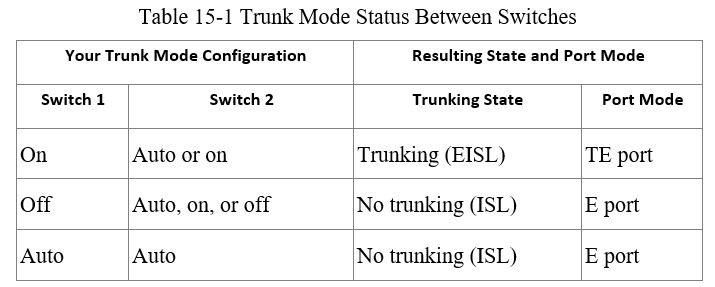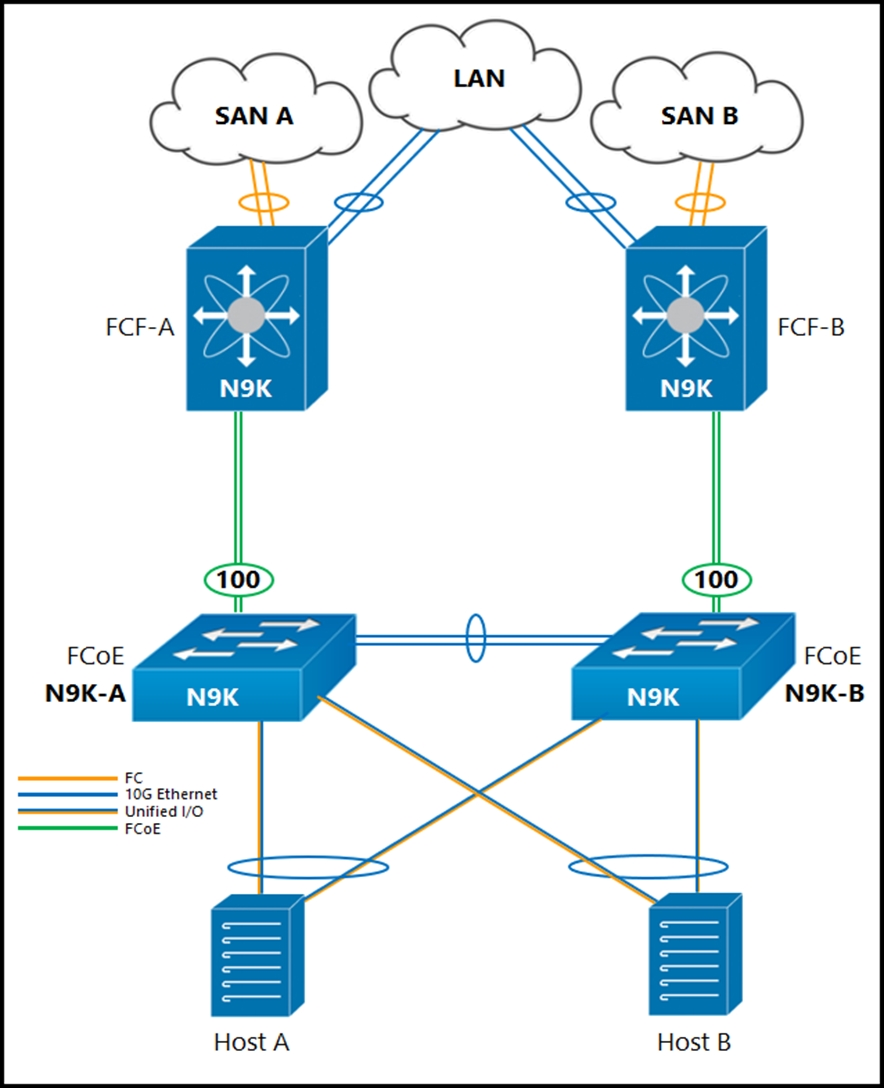Which statement is true about upgrading the firmware on a Cisco MDS storage switch with dual supervisors?
B
Non-Disruptive Upgrades Overview
All MDS switches support non-disruptive upgrades and downgrade subject to limitations listed in the MDS release notes.
On a 95xx or 97xx Series MDS with dual supervisors, during the firmware upgrade, the new code is loaded on the standby supervisor. A switchover then occurs in order to make the supervisor that runs the new code active. The code is then loaded on the previously active supervisor, and it becomes the new standby supervisor. The data plane continues to pass fibre channel traffic. The modules then non-disruptively start at the lowest numbered module and proceed to the highest.
On a 91xx, 92xx, or 93xx Series MDS, which has only one supervisor, the supervisor (control plane) is reloaded. The data plane continues to pass fibre channel traffic.
Reference:
https://www.cisco.com/c/en/us/support/docs/storage-networking/mds-9000-nx-os-san-os-software/118952-technote-mds9k-00.html
A Cisco MDS 9000 Series Storage Switch has reloaded unexpectedly.
Where does the engineer look for the latest core dump file?
D
Saving the Last Core to Bootflash
This last core dump is automatically saved to bootflash in the /mnt/pss/ partition before the switchover or reboot occurs. Three minutes after the supervisor module reboots, the saved last core is restored from the flash partition (/mnt/pss) back to its original RAM location. This restoration is a background process and is not visible to the user.
Reference:
https://www.cisco.com/c/en/us/td/docs/switches/datacenter/mds9000/sw/6_2/configuration/guides/system_management/nx-os/sysmgmt_cli_6-x/ sys.html#37039
An engineer must implement a Cisco UCS system at a customer site. One of the requirements is to implement SAN boot. The storage system maps the source
WWPN to a unique LUN.
Which method does Cisco recommend to configure the SAN boot?
D
Reference:
https://www.cisco.com/c/en/us/td/docs/unified_computing/ucs/ucs-manager/CLI-User-Guides/Server-Mgmt/3-1/ b_Cisco_UCS_Manager_Server_Mgmt_CLI_Guide/server_boot.html#concept_8AD0577BC71F495B88BAF4335C4EF348

Refer to the exhibit. Which feature set must be used to configure on switch 2 to establish a VSAN trunk between switch 1 and switch 2?
A.
✑ F Port
✑ Trunk Mode Passive
B.
✑ N Port
✑ Trunk Mode Active
C.
✑ NP Port
✑ Trunk Mode Auto
D.
✑ E Port
✑ Trunk Mode On
D
By default, trunk mode is enabled in all Fibre Channel interfaces. However, trunk mode configuration takes effect only in E-port mode. You can configure trunk mode as on (enabled), off (disabled), or auto (automatic). The default trunk mode is on. The trunk mode configuration at the two ends of an ISL, between two switches, determine the trunking state of the link and the port modes at both ends (see Table 15-1).
Reference:
https://www.cisco.com/en/US/docs/storage/san_switches/mds9000/sw/rel_3_x/configuration/guides/cli_3_2/trnk.html
An engineer is performing a configuration on a Cisco Nexus 5000 Series Switch. The requirement is for the current Fibre Channel IDs in VSAN 120 to be saved across reboots. The Cisco environment also must integrate with a third-party solution that requires persistent Fibre Channel IDs for the VSAN. The WWN of the
Cisco switch must be 33:e8:00:05:30:00:16:df and its Fibre Channel ID 0x070128. Which command set meets these requirements?
A
Reference:
https://www.cisco.com/en/US/docs/storage/san_switches/mds9000/sw/rel_1_x/1_0_2a/san-os/configuration/guide/Domains.pdf

Refer to the exhibit. An engineer must configure FCoE between the N9K-A switch and the FCF-A Nexus 9000 core switch. The deployment has these characteristics:
✑ The N9K-A and N9K-B top-of-rack switches share the domain ID of the core switches.
✑ The hosts are equipped with converged network adapters.
✑ The only VSAN that is used is permitted to traverse port-channel 100 is VSAN 20.
Which configuration completes the FCoE configuration on the N9K-A device?
B
Reference:
https://www.cisco.com/c/en/us/td/docs/switches/datacenter/nexus9000/sw/93x/fcoe/configuration/guide/b-cisco-nexus-9000-nx-os-fcoe-npv- configuration-guide-933/m_configuring_fc_npv_9x.html
A customer has a requirement for an automation solution that supports periodically acquiring configuration from a centralized server and aligning UCS servers to their desired state.
Which open-source tool meets this requirement?
C
The Puppet software package, developed by Puppet Labs, is an open source automation toolset for managing servers and other resources by enforcing device states, such as configuration settings.
Puppet components include a puppet agent which runs on the managed device (node) and a puppet master (server) that typically runs on a separate dedicated server and serves multiple devices. The operation of the puppet agent involves periodically connecting to the puppet master; which in turn compiles and sends a configuration manifest to the agent; the agent reconciles this manifest with the current state of the node and updates state based on differences.
Reference:
https://www.cisco.com/c/en/us/td/docs/switches/datacenter/nexus3548/sw/programmability/6x/b_Cisco_Nexus_3500_Series_NX-
OS_Programmability_Guide_6x/b_Cisco_Nexus_3500_Series_NX-OS_Programmability_Guide_6x_chapter_01000.html
An administrator needs to configure an automated policy to shut down a link when a given threshold is exceeded on MDS switch.
Which feature needs to be used?
B
EEM consists of three major components:
✑ Event statements ג€" Events to monitor from another Cisco NX-OS component that may require some action, workaround, or notification.
✑ Action statements ג€" Actions that EEM can take, such as sending an e-mail, or disabling an interface, to recover from an event.
✑ Policies ג€" A combination of an event statement and an action statement. When the specified event occurs, the configured action is executed.
What is an advantage of using Ansible for automation as compared to Puppet and Chef?
A
Ansible is a radically simple IT automation engine that automates cloud provisioning, configuration management, application deployment, intra-service orchestration, and many other IT needs.
Designed for multi-tier deployments since day one, Ansible models your IT infrastructure by describing how all of your systems inter-relate, rather than just managing one system at a time.
It uses no agents and no additional custom security infrastructure, so it's easy to deploy - and most importantly, it uses a very simple language (YAML, in the form of Ansible Playbooks) that allow you to describe your automation jobs in a way that approaches plain English.
Reference:
https://www.ansible.com/overview/how-ansible-works
What is required for using Ansible with HTTP/HTTPS protocol in a Cisco NX-OS environment?
D
Reference:
https://docs.ansible.com/ansible/latest/network/user_guide/platform_nxos.html